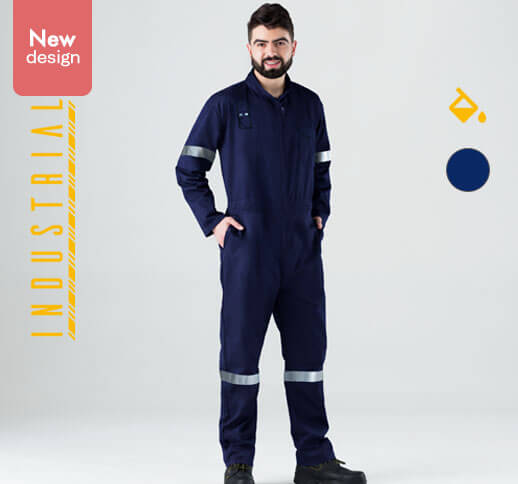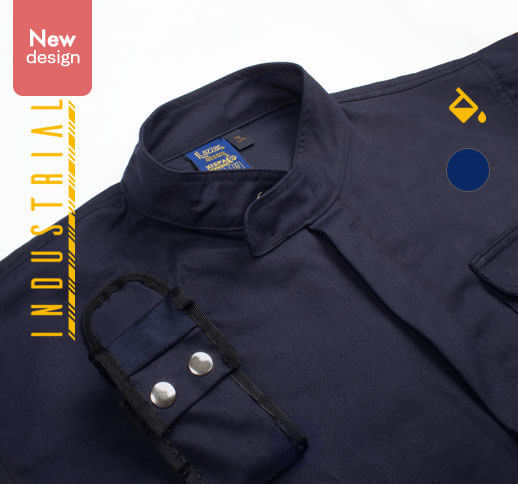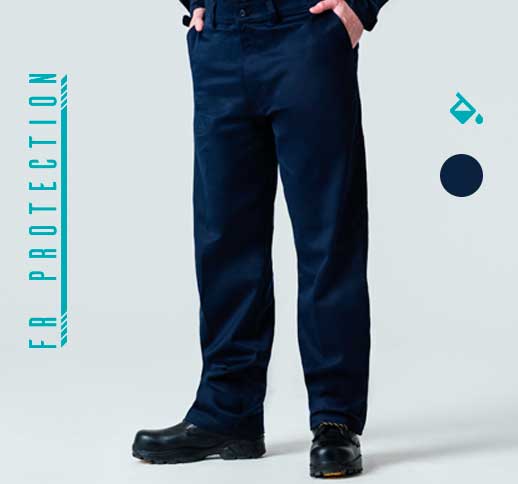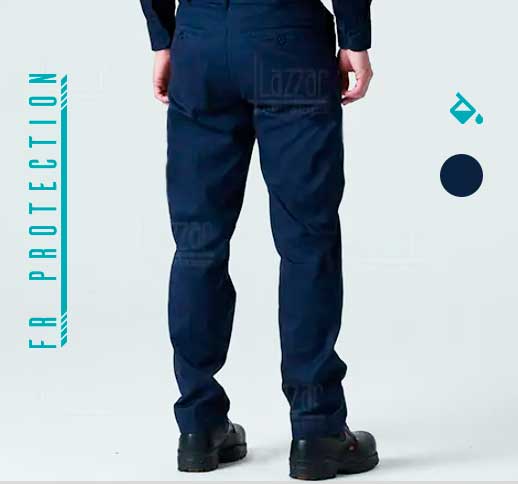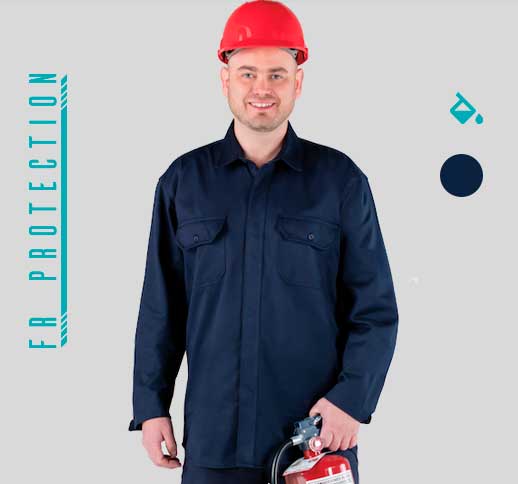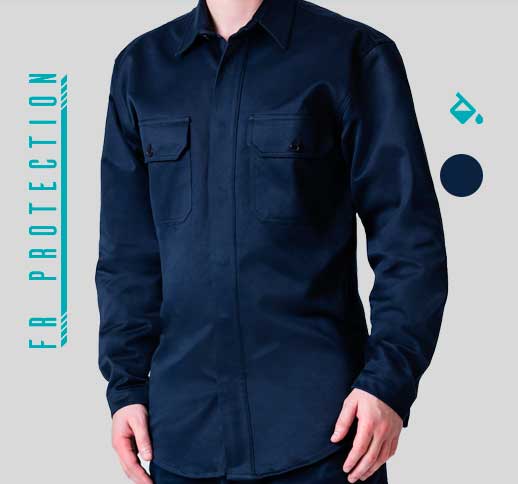Flame-resistant clothing
Keep your team’s safety with our premium flame-resistant (FR) clothing, designed for high-risk work environments. Available for immediate shipping with low minimum order requirements. Our inventory includes:
•Flame-Resistant Long Sleeve Polo Shirt (Navy): Stay protected without compromising comfort. This durable polo offers full flame-resistant coverage with a professional look.
•Flame-Resistant Shirt with Hidden Buttons (Navy): Long sleeve, button-up shirt crafted with the safety standards while offering a sleek, polished appearance.
•Flame-Resistant Pants (Navy): Built for safety and durability, these pants provide reliable flame resistance with maximum comfort.
•Flame-Retardant Coverall (Navy): Designed for full-body protection, this one-piece coverall offers flame resistance and maximum safety.
For heavy-duty use. Other models and thicknesses of flame-resistant clothing can be manufactured starting from 200 pieces. The following fabrics are available:
-Lenard Tech
-Industrial: Xispal 830 or 825 50% Cotton, 39% Acrylic, 10% Viscose, 1% Ant
-Industrial Premium: Valent 937 52% Cotton, 22 Acrylic, 19% Viscose, 6% p-Ara
-Polo shirts: Piqué 825 Inh. Flame Retardant 50% Cotton, 39% Acrylic, 10% Viscose, 1% Ant.
-Sweatshirts: 838 XRS 50% Cotton, 39% Acrylic, 10% Viscose, 1% Ant.
-Jackets: Quilted lining 828
-Acid-resistant: 720AA 100% PPE Protection Class I or Class II
What is flame resistant clothing?
Flame resistant clothing is designed to protect workers from fire-related hazards, extreme heat, and other thermal dangers, such as metal splashes or electric arcs. Inherently flame resistant workwear offers total protection, as its non-flammability properties do not depend on the number of washes, meaning it will never lose this technical feature. This type of protective gear is essential in industries where employees are exposed to high temperatures, sparks, flames, or sudden fires, significantly reducing the risk of severe burns.
Features of flame resistant clothing
Flame resistant garments stand out for their ability to not catch fire easily, even when in direct contact with flames. These clothes are designed to provide reliable protection in high-risk environments. Some key features include:
Heat and flame resistance: The fabrics do not melt or burn easily, allowing the clothing to protect effectively in extreme situations. Additionally, they meet important standards such as EN 11612, which includes flammability tests (EN 15025), radiant heat (ISO 6942), and molten metal splashes (ISO 9185).
Durability: These garments are robust and resistant, designed to withstand extreme working conditions. Durability is also ensured through industrial-style construction, with elements like covered pockets made from the same technical fabric and flaps that cover buttons, meeting safety and protection regulations.
Comfort: Despite their high resistance, many flame resistant garments are designed to be comfortable, lightweight, and flexible, allowing freedom of movement. Comfort is achieved through breathable fabrics that ensure ease during extended periods of use.
Anti-static: Some garments include carbon fiber to dissipate electrostatic charges, preventing the buildup of static electricity, which could generate dangerous sparks, especially in ATEX zones (explosive atmospheres), such as in the petrochemical industry, paint factories, or handling solvents or chemicals. These garments comply with the anti-static standard EN 1149/3/5.
The key to selecting inherently flame resistant workwear is understanding the specific risks of the industry to offer the most appropriate solutions. Besides design and comfort, it is essential that these garments meet relevant standards, such as ASTM F1506, necessary for compliance with NFPA 70E, which protects against thermal risks from a possible electric arc.
Types of flame resistant clothing by job
There are different types of flame resistant clothing depending on the specific job needs and associated risk levels:
Flame resistant coveralls: These cover the entire body and are ideal for jobs in refineries, petrochemical plants, or welding. For these sectors, such as petrochemical, wind, or photovoltaic, the recommended coverall is ref. 825 Xispal, designed for high-risk environments.
Flame resistant jackets and pants: These are used in combination to provide protection while allowing flexibility in jobs like mining or construction. If the risk is related to maintenance tasks or small metal splashes, one can opt for a shirt, pants, or coverall from ref. 830 Xispal.
High-visibility flame resistant clothing: Used in environments where fire protection and high visibility are required, such as traffic zones or road construction.
It's important to determine the type of job and risk area before selecting workwear. For example, in the electrical sector, where there is a risk of electric arc up to 8 cal/cm², the recommended polo shirt is ref. 822R1, category 2. By understanding the work environment, the most suitable inherently flame resistant clothing can be chosen, ensuring maximum protection without losing functionality.
What level of fire resistance do they have?
The level of fire resistance of flame resistant clothing varies depending on the material and certification of the garments. These must comply with international standards, such as NFPA 2112 or ISO 11612, ensuring their ability to withstand direct flames, convective heat, and other types of thermal exposure. The resistance can be temporary (during direct exposure) or permanent, depending on the material.
In the case of inherently flame resistant workwear, all fabrics are designed never to catch fire, even in extreme heat conditions. However, at very high temperatures, the fabrics may char or crystallize, especially at levels of 260 degrees Celsius. Despite this reaction to high temperatures, the garments will not ignite or spread the fire, providing reliable protection in high thermal risk environments.
What care should you take when choosing flame resistant clothing?
When choosing flame resistant clothing, it's important to consider several factors to ensure its effectiveness and durability:
Adequate protection level: Make sure the garment complies with the safety standards required for your work environment, such as NFPA 2112 or ISO 11612.
Comfort and fit: The clothing should be comfortable for prolonged use and not restrict movement. Proper fit is essential to ensure both protection and ease of movement on the job.
Compatibility with other protective equipment: Ensure the garment is compatible with helmets, gloves, and other personal protective equipment to maintain safety throughout the protection system.
Maintenance and washing: Follow the manufacturer’s recommendations to prolong the lifespan of the clothing and ensure it retains its flame resistant properties. For inherently flame resistant garments, it is preferable to wash them with liquid soaps, avoiding the use of softeners, peroxides, or bleach, as these products can affect the color, although they will never lose their flame resistant technical feature. Industrial laundries can be used to remove grease or oil from the garments.
In the case of ref. 825 or 830 Xispal garments, the maximum washing temperature is 75 degrees, and drying tunnels can reach 150 degrees. For ref. 822R1 Xispal garments, the maximum washing temperature is 40 degrees, and drying should be done at a maximum temperature of 90 degrees.
These are instructions will ensure the durability and optimal performance of flame resistant clothing over time, maintaining its protective effectiveness in demanding work conditions.








